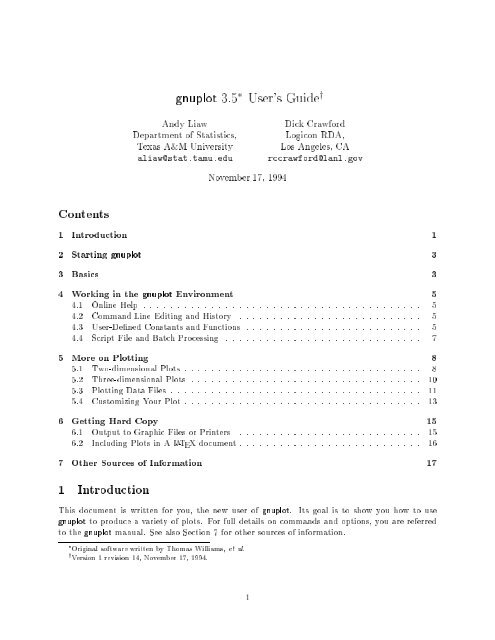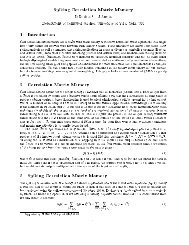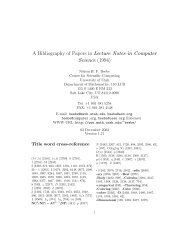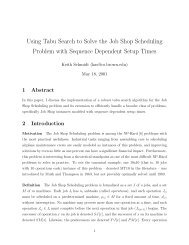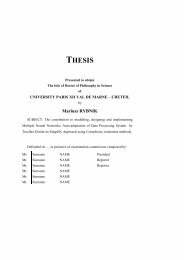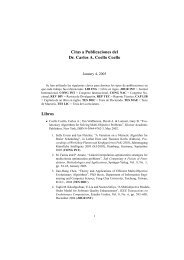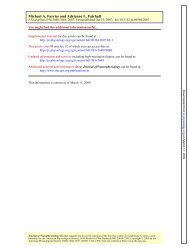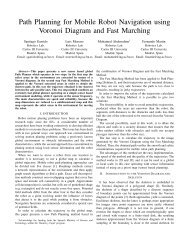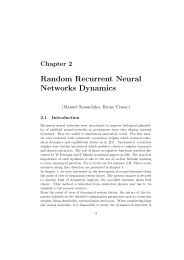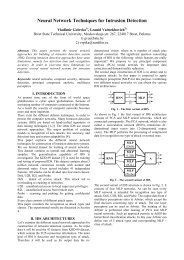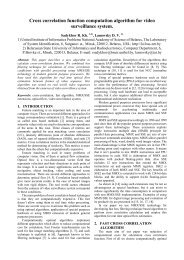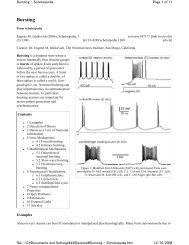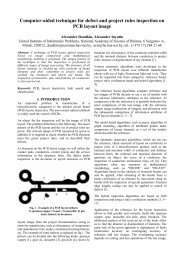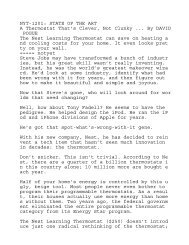gnuplot 3.5 User's Guide Contents 1 Introduction
gnuplot 3.5 User's Guide Contents 1 Introduction
gnuplot 3.5 User's Guide Contents 1 Introduction
Create successful ePaper yourself
Turn your PDF publications into a flip-book with our unique Google optimized e-Paper software.
<strong>Contents</strong><br />
<strong>gnuplot</strong> <strong>3.5</strong> <strong>User's</strong> <strong>Guide</strong> y<br />
Andy Liaw<br />
Department of Statistics,<br />
Texas A&M University<br />
aliaw@stat.tamu.edu<br />
November 17, 1994<br />
Dick Crawford<br />
Logicon RDA,<br />
Los Angeles, CA<br />
rccrawford@lanl.gov<br />
1 <strong>Introduction</strong> 1<br />
2 Starting <strong>gnuplot</strong> 3<br />
3 Basics 3<br />
4 Working in the <strong>gnuplot</strong> Environment 5<br />
4.1 Online Help : : : : : : : : : : : : : : : : : : : : : : : : : : : : : : : : : : : : : : : : : 5<br />
4.2 Command Line Editing and History : : : : : : : : : : : : : : : : : : : : : : : : : : : 5<br />
4.3 User-De ned Constants and Functions : : : : : : : : : : : : : : : : : : : : : : : : : : 5<br />
4.4 Script File and Batch Processing : : : : : : : : : : : : : : : : : : : : : : : : : : : : : 7<br />
5 More on Plotting 8<br />
5.1 Two-dimensional Plots : : : : : : : : : : : : : : : : : : : : : : : : : : : : : : : : : : : 8<br />
5.2 Three-dimensional Plots : : : : : : : : : : : : : : : : : : : : : : : : : : : : : : : : : : 10<br />
5.3 Plotting Data Files : : : : : : : : : : : : : : : : : : : : : : : : : : : : : : : : : : : : : 11<br />
5.4 Customizing Your Plot : : : : : : : : : : : : : : : : : : : : : : : : : : : : : : : : : : : 13<br />
6 Getting Hard Copy 15<br />
6.1 Output to Graphic Files or Printers : : : : : : : : : : : : : : : : : : : : : : : : : : : 15<br />
6.2 Including Plots in A L ATEX document : : : : : : : : : : : : : : : : : : : : : : : : : : : 16<br />
7 Other Sources of Information 17<br />
1 <strong>Introduction</strong><br />
This document is written for you, the new user of <strong>gnuplot</strong>. Itsgoalistoshowyou how to use<br />
<strong>gnuplot</strong> to produce a variety of plots. For full details on commands and options, you are referred<br />
to the <strong>gnuplot</strong> manual. See also Section 7 for other sources of information.<br />
Original software written by Thomas Williams, et al.<br />
y Version 1 revision 14, November 17, 1994.<br />
1
<strong>gnuplot</strong> is a command-line driven interactive plotting program. It is very easy to use (it actually<br />
has only two commands for creating plots: plot and splot), yet it is very powerful. It can produce<br />
several di erent kinds of plots with many options for customizing them, and can send the result to<br />
a wide range of graphic devices (graphics terminals, printers, or plotters).<br />
To give you some idea of the capabilities of <strong>gnuplot</strong>, here are some of the things that one can<br />
do with the program:<br />
Univariate data series plots (e.g. time series)<br />
Simple plots of built-in or user-de ned functions (including step functions) in either Cartesian<br />
or polar coordinates<br />
Scatter plots of bivariate data, with errorbar options<br />
Bar graphs<br />
Three-dimensional surface plots of functions like z = f(x y), with options for hidden line<br />
removal, view angles, and contour lines<br />
Three-dimensional scatter plots of trivariate data<br />
Two- and three-dimensional plots of parametric functions<br />
Plot data directly from tables created by other applications<br />
Re-generate plots on a variety of other graphic devices<br />
An example of plot created in <strong>gnuplot</strong> is show in Figure 1. 1<br />
0:2<br />
0:15<br />
0:1<br />
0:05<br />
0<br />
z<br />
A Bivariate Density<br />
1<br />
2<br />
exp[; 1<br />
2 (x2 + y 2 )]<br />
;4 ;3 ;2 ;1 1 2 3 4<br />
x 0 1 2 3 4 ;4 ;3 ;2 ;10 y<br />
Figure 1: An example of plot produced by <strong>gnuplot</strong>.<br />
In the following sections, you will learn how todoalloftheabove (and some more) in <strong>gnuplot</strong>.<br />
1 This plot was created with the terminal type eepic. See Section 6.2 for more details.<br />
2
2 Starting <strong>gnuplot</strong><br />
<strong>gnuplot</strong> is available for a large number of computers using a variety of operating systems, including<br />
IBM-PCs and compatibles, many Unix workstations, Vax/VMS, Atari ST, and Amiga. For the<br />
purposes of this document, it is assumed that you are using either a PC (running MS-DOS, MS-<br />
Windows 3.1, or OS/2 2.x) or a Unix workstation (running X Windows). It is also assumed that<br />
you have <strong>gnuplot</strong> properly installed on your system. Please refer to the README les included in the<br />
distribution for installation instructions.<br />
To start <strong>gnuplot</strong> under MS-DOS or Unix, just type the command<br />
<strong>gnuplot</strong><br />
You will see the opening message and the <strong>gnuplot</strong>> prompt. If you get an error message like<br />
\command not found", make sure that the directory where <strong>gnuplot</strong> resides is listed in the PATH<br />
statement in the le autoexec.bat (for DOS) or the initialization le (for Unix).<br />
To start <strong>gnuplot</strong> under MS Windows, double-click onthe <strong>gnuplot</strong> icon. The <strong>gnuplot</strong> window<br />
will pop up with menus and buttons along the top, the opening message and the <strong>gnuplot</strong>> prompt<br />
inside the window.<br />
To start <strong>gnuplot</strong> under OS/2, open the folder where <strong>gnuplot</strong> is located, and double click on the<br />
<strong>gnuplot</strong> icon. The <strong>gnuplot</strong> window will pop up with the opening message and the <strong>gnuplot</strong>> prompt.<br />
The last line of the opening message tells you the \terminal type" currently set. For Unix it<br />
should be X11, for MS-DOS vgalib (if you have aVGA monitor), for MS Windows windows, and<br />
for OS/2 os2. Note: If you are on a PC running Kermit to connect to Unix via a modem, you<br />
can type the command:<br />
set terminal kc_tek40xx<br />
if you have a color monitor, or<br />
set terminal km_tek40xx<br />
if you have a monochrome monitor. This will enable you to see the high resolution plot on your<br />
PC screen. To restore the screen to text mode, set the terminal type to dumb.<br />
To exit <strong>gnuplot</strong>, you can type either exit, quit, or simply q.<br />
3 Basics<br />
To start exploring <strong>gnuplot</strong>, try the following commands:<br />
plot cos(x)<br />
plot [-pi:pi] sin(x**2),cos(exp(x))<br />
splot [-3:3] [-3:3] x**2*y<br />
The rst plot command produces a plot of cos x. The second plot command produces a plot of<br />
the functions sin x 2 and cos e x on the same graph, with x in the range (; ). The third command<br />
produces a three-dimensional surface plot of the function f(x y) =x 2 y. Note that you have used<br />
<strong>gnuplot</strong>'s built-in functions sin(), cos(), and exp(), aswell as the built-in constant pi. There<br />
are many more. Please refer to the <strong>gnuplot</strong> manual for a complete list.<br />
Here are explanations of the above commands. The plot command tells <strong>gnuplot</strong> that you want<br />
to create a two-dimensional plot. In the rst example, the range of x is not speci ed, so <strong>gnuplot</strong><br />
3
use its default range of (;10 10). In the second example, the phrase [-pi:pi] following plot<br />
tells <strong>gnuplot</strong> to produce the plot with x in the range (; ). There are two functions speci ed,<br />
separated by a comma. This tells <strong>gnuplot</strong> to plot both functions on the same plot. Note that on a<br />
color screen, <strong>gnuplot</strong> uses di erent colors for the functions. On a monochrome display, the functions<br />
are plotted with di erent linestyles. The third command tells <strong>gnuplot</strong> to create a three-dimensional<br />
plot (well, actually a two-dimensional projection of a three-dimensional plot, but you know that).<br />
The two pairs of brackets following splot set the range of the x-axis ( rst set of brackets) and the<br />
range of y-axis (second set of brackets). Note that the ranges are optional in both plot and splot.<br />
If ranges are not speci ed, <strong>gnuplot</strong> uses the ranges previously set. The ranges of y-axis in plot and<br />
the z-axis in splot are autoscaled by default, if not speci ed.<br />
If you want to specify the y-range but not the x-range, put in both sets of brackets but leave<br />
the rst set empty, like<br />
plot [] [0:2] 1/(1+x**2)<br />
The same trick works with splot.<br />
The command set is used to control many options available in <strong>gnuplot</strong> (you have already seen<br />
set terminal). Many of the options control the appearance of the plot. In the previous examples,<br />
you saw that the ranges of the axes can be speci ed in the plotting command. The ranges can<br />
also be set before plotting, with the commands set xrange, set yrange, andset zrange. For<br />
example:<br />
set xrange [-.3:<strong>3.5</strong>]<br />
set yrange [:pi**2]<br />
set zrange [exp(3.66)/sin(1.2*pi):]<br />
Note that you can omit either the upper or lower limits. The limits can be either numbers, prede<br />
ned constants , or expressions as complicated as in the third example.<br />
The di erence between setting the ranges with plot (or splot) and with set xrange (or yrange<br />
or zrange) is that in the former case the ranges apply only to that single plot, whereas in the latter<br />
case they apply to all subsequent plots { until the ranges are reset, of course. (If the ranges are set<br />
both ways, the ones on the plot command will be used.) This is the case for all set commands.<br />
If you have set a range and want to return to <strong>gnuplot</strong>'s automatic range selection, the command<br />
is set autoscale haxisi, where haxisi is some combination of x, y, andz and, if you omit it, all<br />
axes will be autoscaled.<br />
You can also add axis labels and a title to the plot by the commands set xlabel, set ylabel,<br />
set zlabel, andset title. For example:<br />
set xlabel 'x'<br />
set ylabel "Power Function"<br />
set zlabel 'Time (sec)'<br />
set title 'Some Examples'<br />
replot<br />
Note that both single quote and double quote are acceptable (but they must match). The replot<br />
command does what its name suggests it redraws the previous plot, incorporating whatever changes<br />
have been introduced by intervening set commands. You'll be using replot a lot when you are<br />
customizing a plot (which you'll learn how to do in Section 5).<br />
You can also add another curve to the previous plot. Try<br />
4
plot [-2*p1:2*pi] sin(x)<br />
replot tan(x)<br />
Note that the y-range adjusts itself. You cannot specify new ranges for the plot on the replot<br />
command (use the set commands), but you can do everything else that you can do with plot.<br />
4 Working in the <strong>gnuplot</strong> Environment<br />
<strong>gnuplot</strong>'s interactive environment has many features that make it easy to use. In this section you<br />
will learn about some of these features.<br />
4.1 Online Help<br />
<strong>gnuplot</strong> provides very detailed online help for all commands. The entries in the online help are<br />
identical to those you nd in the <strong>gnuplot</strong> manual. To access the help facility, simply type a question<br />
mark (?) or help at the <strong>gnuplot</strong>> prompt. To get help on a particular command, type ?<br />
hcommand i. Ifyou are using the DOS version and can not access the online help, please read the<br />
README le and check tomake sure that <strong>gnuplot</strong> is properly installed on your PC.<br />
4.2 Command Line Editing and History<br />
<strong>gnuplot</strong> has a mechanism that allows you to recall previous commands and edit them. On the<br />
PC, the up/down arrow keys are used to get the previous/next commands. The Home, End, and<br />
left/right arrowkeys are used to move the cursor around (the Home and End keys move the cursor<br />
to the beginning and end of the line, respectively.). On Unix, the arrow keys can be used if you<br />
have the correct terminal setting. Otherwise the Emacs control sequence can be used (e.g., ^p for<br />
previous command, ^n for next command, ^b to move left one character, ^f to move right one<br />
character, ^d to delete a character, etc.).<br />
Another nice feature of <strong>gnuplot</strong>'s command line is that it will accept abbreviations of commands<br />
and keywords as long as they are not ambiguous. For example, replot can be abbreviated as rep,<br />
parametric as par, linespoints as linesp, etc. While this is handy for interactive <strong>gnuplot</strong><br />
sessions, it may not be a good idea to abbreviate commands in script les (to be discussed later)<br />
because it make the commands less comprehensible.<br />
4.3 User-De ned Constants and Functions<br />
You should familiarize yourself with the arithmetic and logical expressions in <strong>gnuplot</strong>. Basically,<br />
they are similar to Fortran and C expressions, e.g. ** for exponentiation, && for logical AND, ||<br />
for logical OR, etc. For details on the complete set of operators, refer to the <strong>gnuplot</strong> manual.<br />
If you use some constants or functions repeatedly in your work, you might nd it convenient to<br />
give them names that are easier to remember. For example, if you use the constants =10:98765<br />
and =6:43321 very often, you can name them in <strong>gnuplot</strong> by<br />
mu=10.98765<br />
sigma=6.43321<br />
Now suppose you want to plot the function f(x) = 1 p<br />
2<br />
plot 1/(sqrt(2*pi)*sigma)*exp(-(x-mu)**2/(2*sigma**2))<br />
5<br />
;(x; )<br />
e<br />
2<br />
2 2 .You can now do
You may nd typing the above function cumbersome, especially if you need to use it several times.<br />
<strong>gnuplot</strong> lets you do this:<br />
f(x,mu,sigma)=1/(sqrt(2*pi)*sigma)*exp(-(x-mu)**2/(2*sigma**2))<br />
(You could leave themu and sigma out of the argument listifyou don't need to vary them.) You<br />
can now do things like<br />
plot [-5:15] f(x,6,1),f(x,<strong>3.5</strong>,2)<br />
Numbers without decimal points are treated as integers rather than as reals. Expressions using<br />
only integers are evaluated by integer arithmetic. Thus 1./4. = 0.25, but 1/4 = 0. This can lead<br />
to wrong results if you are not careful.<br />
Being able to de ne custom functions has a few advantages other than saving typing. Here is<br />
a handy trick: suppose you have the following function:<br />
f(x) =<br />
8<br />
< x(1 ; x) x4<br />
De ning this function in <strong>gnuplot</strong> can be done by stringing a few functions together:<br />
f1(x)=(x
f(x) = exp(-x**2)<br />
delta = 0.02 # If you're running under MS-DOS, use delta = 0.2<br />
# integral2_f(x,y) takes two variables x is the lower limit,<br />
# and y the upper. Calculate the integral of function f(t)<br />
# from x to y<br />
integral2_f(x,y) = (xy)?0:(integral2(x+delta,y)+delta*f(x))<br />
Note that f(x) is de ned as e ;x2.<br />
Toplot the function and its integral R x<br />
;10 e;x2 dx, you can just<br />
do<br />
plot f(x),integral2_f(-10,x)<br />
There is a command, print, which will evaluate an expression and print the result on the screen.<br />
For example, try the following:<br />
print cos(pi)<br />
print exp(-0.5*(1.96)**2)/sqrt(2*pi)<br />
One implication of this is that you can use <strong>gnuplot</strong> as a calculator. 2<br />
4.4 Script File and Batch Processing<br />
Sometimes you will want to use the same set of commands many times. <strong>gnuplot</strong> allows you to put<br />
those commands in a script le and load the le into <strong>gnuplot</strong>. You can use a text editor (such as<br />
Emacs, vi, or Norton Editor) to create or edit such a le. Once you have created the le, you can<br />
run the commands in that le in two ways. First, you can run <strong>gnuplot</strong> and use the load command<br />
to run the commands in the script. The other way istorunthescriptinbatch mode by typing the<br />
lename of the script as the command line argument to the <strong>gnuplot</strong> command. For example, to<br />
run the script called myplot.gp in batch mode,type<br />
<strong>gnuplot</strong> myplot.gp<br />
This will invoke <strong>gnuplot</strong>. After it nishes executing the commands in the script, it exits, and you<br />
are back to the system command prompt. (There is a pause command, which will be discussed<br />
later.) This is convenient ifyou want to output plots to some graphics le instead of viewing them<br />
on the screen.<br />
A few special characters are very useful in script les. Everything after a number sign, #, on<br />
a single line in a script (or, for that matter, on a command line) is treated as a comment and is<br />
ignored by <strong>gnuplot</strong>. The continuation character is the backslash, n. Multiple commands can be<br />
placed on a single line if you separate them by a semicolon, .<br />
Suppose you have de ned some variables and functions and customized some settings with the<br />
set command. If you want tokeep all these so that you can use them later, you can write all these<br />
(along with all of the default values you have not set and the last plot or splot command) to a<br />
le by<br />
save 'mystuff.gp'<br />
2 Actually, there is a terminal type table in <strong>gnuplot</strong> which, when you plot or splot a function, prints a table of<br />
values (x and f(x) for plot, and x, y, and f(x y) for splot).<br />
7
The lename and extension are arbitrary, of course. If you only want tosave the functions you<br />
have de ned, you can use<br />
save function 'myfunc.gp'<br />
The same applies to variable and set.<br />
To load the le into <strong>gnuplot</strong>, use the load command. For example:<br />
load 'mystuff.gp'<br />
Included in the <strong>gnuplot</strong> distribution, along with demo les, is a le named stat.inc, which<br />
contains de nitions of many cumulative distribution functions and probability density (or mass)<br />
functions for many continuous and discrete distributions. To access these functions, you can do<br />
load 'stat.inc'. The demo les prob.dem and prob2.dem show how these functions can be used.<br />
5 More on Plotting<br />
You have already seen the basic plotting commands in Section 2. In this section, you will learn<br />
how to create several di erent kinds of plots with <strong>gnuplot</strong>.<br />
5.1 Two-dimensional Plots<br />
<strong>gnuplot</strong> can create two types of two-dimensional plots. The rst is the usual y = f(x) in Cartesian<br />
coordinates or r = f( ) in polar coordinates. The other type is a parametric curve (e.g. x = t 2 y=<br />
cos t). Plotting y = f(x) should be a trivial task after going through the previous sections. To plot<br />
r = f( ) in polar coordinates, you rst tell <strong>gnuplot</strong> to switch to polar coordinates by the command<br />
set polar. The syntax for plotting functions in the polar coordinates is exactly the same as that<br />
for Cartesian coordinates, except that x is the angle and the value of the function is the radius.<br />
For example, to plot the function r = 1 ,you can do the following:<br />
cos x<br />
set polar<br />
plot 1/cos(x)<br />
Note that the default unit for the angle is radians. You can change the unit to degrees by set<br />
angle degree. You can change the name of the dummy variable from x to theta by<br />
set dummy theta<br />
plot 1/cos(theta)<br />
To switch back to Cartesian coordinates, use the command set nopolar.<br />
Parametric curves are very handy. If you de ne the x- and y-coordinates as functions of a<br />
dummy variable, t, you can plot things like circles, ellipses, and other curves that cannot be<br />
expressed in the functional form y = f(x). Try the following examples:<br />
set parametric<br />
plot sin(t), cos(t)<br />
plot 3*sin(t-3), 2*cos(t+2), cos(3*t), sin(2*t)<br />
set noparametric<br />
8
The rst command tells <strong>gnuplot</strong> that you want to plot parametric curves. The rst plot is a circle<br />
(with aspect ratio distortion). The second plot shows an ellipse (the functions x = 3 sin(t ; 3) y=<br />
2 cos(t + 2)), and a strange-looking curve (the functions x = cos 3t y =sin2t). Note that up to<br />
three ranges can be speci ed on the plot command, in the order t, x, andy. The command set<br />
noparametric switches back to ordinary y = f(x) mode.<br />
You can also plot parametric curves in polar coordinates. In this case you de ne r = r(t) and<br />
= (t). Try the following:<br />
set parametric set polar<br />
plot sin(t),cos(t)<br />
Did you guess what the curve will look like?<br />
In parametric polar mode, rrange sets the distance from the origin to the edge, xrange sets<br />
the angle, and yrange sets the extent of the plot, which will be square. For instance, try:<br />
set parametric set polar<br />
set rrange [-1:1] set yrange [-2:2]<br />
plot t,0<br />
Note that under parametric mode, the range of t can be speci ed bytheset trange command.<br />
The syntax is the same as set xrange.<br />
You can set the number of points where each function is to be evaluated by the command set<br />
samples. For example:<br />
set samples 100 plot f(x)<br />
set xrange [0:-10] set samples 11 plot g(x)<br />
The rst example tells <strong>gnuplot</strong> to plot f(x)at100points equally-spaced in the default x-range. The<br />
second example tells <strong>gnuplot</strong> to plot g(x) atinteger-valued x from0to;10 (yes, you can reverse<br />
the direction that an axis increases just by specifying the endpoints appropriately).<br />
By now you have noticed that each function is listed in the key in the upper right-hand corner<br />
of the plot. Perhaps you'd like to specify a title other than the one <strong>gnuplot</strong> gives you by default.<br />
The option is simply title 'hcurve-namei'. Similarly you can control how thecurve is shown by<br />
adding the option with hstylei where hstylei can be lines, points, impulses, etc. The <strong>gnuplot</strong><br />
manual has the complete list. If you have several curves on your plot and they are plotted with the<br />
same style, <strong>gnuplot</strong> has several versions of each style which it cycles through. You can override its<br />
selections by adding the integral style codes (line, then point) after with hstylei. (You can see all<br />
of the available options by entering the command test.) Try<br />
set samples n+1 set xrange [0:n]<br />
mu=5 n=15 p=0.4<br />
i(x)=int(x+.1)<br />
pd(x)=mu**x*exp(-mu)/i(x)!<br />
bd(x)=n!/(i(x)!*(n-i(x))!)*p**x*(1-p)**(n-x)<br />
plot bd(x) title 'binomial distribution, p=0.4' with linespoints,\<br />
pd(x) title 'Poisson distribution, mu=5' with impulses<br />
You can leave a function out of the key entirely by replacing title '...' with notitle, andyou<br />
can eliminate the key completely by the command set nokey.<br />
If you want to plot a bargraph, use with boxes. The width of the bars are controlled by the set<br />
boxwidth command. Without any argument, set boxwidth tells <strong>gnuplot</strong> to calculate the width so<br />
that successive bars are adjacent to each other (as in a histogram).<br />
9
5.2 Three-dimensional Plots<br />
For three-dimensional plots, <strong>gnuplot</strong> supports only Cartesian coordinates. Therefore you can only<br />
plot surfaces of the type z = f(x y) orx = x(u v) y= y(u v) z= z(u v). Try the following:<br />
set hidden3d<br />
f(x,y)=x**2+x*y-y**2<br />
splot f(x,y)<br />
set parametric<br />
splot u-v**2, u**2*v, exp(v)<br />
set noparametric<br />
The command set hidden3d turns on the hidden-line removal, which means lines \behind" other<br />
lines are not drawn. This feature is not available in the MS-DOS version due to memory limitations.<br />
The Windows, OS/2 and Unix versions do support this feature, however.<br />
<strong>gnuplot</strong> can generate contour lines on the xy-plane, on the surface itself, or both. The command<br />
is set contour hplacei,wherehplacei is either base, surface,orboth. You can control the contour<br />
levels by the command set cntrparm hoptionsi. Here are a few examples:<br />
set cntrparam levels auto 5 # set 5 automatic levels<br />
set cntrparam levels incr 0,.1,1 # 11 levels from 0 to 1<br />
set cntrparam levels disc .1,.2,.4,.8 # 4 discrete levels<br />
Please refer to the online help or the <strong>gnuplot</strong> manual for more advanced options for set cntrparam.<br />
Note that on a color output device, contour lines at di erent levels are drawn with di erent<br />
colors. On a monochrome display or non-color printer, they are shown in di erent line styles. Also<br />
note that if you specify contours on the surface and turn on the hidden-line removal, the contour<br />
lines will not be shown. This is because contour lines are drawn \underneath" the surface, not on<br />
top of the surface. You can specify set nosurface to plot only the contour lines.<br />
<strong>gnuplot</strong> cannot generate a contour plot from parametric functions.<br />
The number of values of each coordinate for which the function is evaluated (and hence the<br />
number of lines on the surface) is set by the command set isosamples hx-number i, hy-number i,<br />
where hx-number i and hy-number i are the number of lines to draw along the x- andy-axes. set<br />
samples (discussed above) sets the number of points evaluated along each isosample.<br />
Sometimes you may want to look at the three-dimensional surface plot from another direction.<br />
This is accomplished by the set view command. The rst number following set view changes<br />
the rotation angle around the x-axis and the second changes the rotation around the z-axis. The<br />
default view is 60 degrees about the x-axis and 30 degrees about the z-axis. For example, try<br />
set xlabel 'x' set ylabel 'y'<br />
splot [0:1] [0,1] x**2*y*(1-y)<br />
set view 15,75<br />
replot<br />
Try a few other rotations.<br />
You can make atwo-dimensional contour map of a surface by using the settings<br />
set nosurface<br />
set contour<br />
set view 0,0<br />
replot<br />
10
ut the y-axis is labeled on the right. Di erent rotations around the z axis may come closer to<br />
what you want.<br />
5.3 Plotting Data Files<br />
<strong>gnuplot</strong> can produce plots from tabulated data. In this section, you will see how to handle di erent<br />
kinds of data with <strong>gnuplot</strong>. Note that you can put comments in a data le the same way you can<br />
in a <strong>gnuplot</strong> script le <strong>gnuplot</strong> ignores everything on the line after the # symbol.<br />
The essential rule of data organization is that <strong>gnuplot</strong> reads one data point per line.<br />
Perhaps the simplest data to plot are a series. Suppose you have the data for a variable<br />
stored in a column in a plain text le. The command plot 'hdata- lenamei' will plot the values<br />
of the variable as the y-coordinates { the rst value with x-coordinate 0, the second value with<br />
x-coordinate 1, etc. This is useful for plotting time series data.<br />
If your data really are a time series, you may want a plot where the x-axis is either the dayof-the-week<br />
or the month. The commands set xdtics and set xmtics will do these for you. For<br />
xdtics, 0 is treated as Sunday, 1 as Monday and so on. Numbers larger than 6 are converted<br />
modulo 7. For xmtics, 1 is treated as January, 2 as February and so on. Numbers larger than 12<br />
are converted modulo 12 plus 1.<br />
You can also plot series from a bivariate data set. In this case the rst column in the data le<br />
is taken as the x-coordinate and the second column is taken as the y-coordinate. This allows you<br />
to plot data with scattered x's or series data with a variable step size.<br />
The data le can have many columns. You can tell <strong>gnuplot</strong> which columns to plot by the using<br />
keyword following 'hdata- lenamei' on the plot command. For example, suppose your data set is<br />
stored in the le reg.dat and contains ten columns. Consider the following commands:<br />
plot 'reg.dat' using 1:2<br />
plot 'reg.dat' using 2:3, 'reg.dat' using 2:6,\<br />
'reg.dat' using 8:4 with lines<br />
The rst command plots the rst column in the le as x and the second column as y (which isthe<br />
default). The second command overlays three plots: third column (y) versus second column (x),<br />
sixth column (y) versus second column (x), and fourth column (y) versus eighth column (x). The<br />
rst two are plotted with points, and the third with a line.<br />
With the using option, you can now plot data directly from labeled tables prepared by some<br />
other program, as long as you remember to put the # at the beginning of each heading line.<br />
When you plot a data set with style lines, anull line (a line of zero length { not a line of<br />
spaces) in the data le breaks the line in the plot.<br />
If you wish to put error bars on your plotted data, you need to give <strong>gnuplot</strong> the error data in<br />
either a three-column (x, y, y) or a four-column (x, y, y low, y high) format. You then specify with<br />
errorbars. There is also a style boxerrorbars, which requires a fth column of data containing<br />
the box width.<br />
If you want tohave control over the width of the bars in a bar graph, the bar width data must<br />
be in the fth column of the data le (or the fth item in the using list, e.g. using 1:2:2:2:3 for<br />
a three-column le) or de ned by the command set boxwidth.<br />
If you have lots of data and only want to put error bars on some of them, there is no way to<br />
do so directly in <strong>gnuplot</strong>. You'll need to make a separate le with the subset, or you could edit<br />
the data le, setting the errors to zero for those points to be plotted without error bars. If you're<br />
running under Unix, you could use a lter like awk to do the same thing.<br />
11
One nice feature of <strong>gnuplot</strong> is that it can transform the y values of the data with the thru<br />
option of the plot command. For example,<br />
plot 'reg.dat' thru sqrt(x)<br />
produces the same plot as the rst example above, except that the y data are transformed to p y.<br />
The function doesn't have to be one built into <strong>gnuplot</strong> you can de ne one yourself. Just remember<br />
that the syntax is a bit odd you plot thru f(x) even though you're really plotting f(y). A<br />
transformation can only be applied to the y data in a two-dimensional plot currently there is no<br />
built-in mechanism in <strong>gnuplot</strong> to transform the x data, nor is there any transformation available<br />
for three-dimensional plots. A short discussion of thru can be found in the manual or online help,<br />
under plot data- le, which also mentions how to transform both x and y with awk under Unix.<br />
If you are interested in tting a curve toasetofx-y data, there are several programs (fudgit<br />
and gnufit 3 , for example) that perform nonlinear least squares ts. Each of these couples easily to<br />
<strong>gnuplot</strong>. Ifyou are looking for more extensive features, check out Octave 4 (available for Unix only).<br />
Octave is a Matlab-like program that performs many numerical computations. It uses <strong>gnuplot</strong> as<br />
its plotting tool. Thus you can do curve tting to your data and then pass the result to <strong>gnuplot</strong><br />
from Octave, for instance.<br />
You can create three-dimensional scatter plots as easily as two-dimensional ones. Suppose the<br />
data le 3d.dat contains ve columns of numerical data. The commands<br />
splot '3d.dat'<br />
splot '3d.dat' using 1:4:3<br />
rst plot the points (x y z) with rst column as x, secondasy, and third column as z, and then<br />
rst column as x, fourth column as y, and third column as z.<br />
The le 3d.dat can even contain more than one set of data. If you separate the sets with two<br />
null lines, <strong>gnuplot</strong> will refer to the rst set as index 0, the second as index 1, andsoon.You tell<br />
<strong>gnuplot</strong> which one to plot by placing index and the number immediately after hdata- lenamei. (It<br />
is a pity that plot doesn't have this option, too.)<br />
If you want to makeacontour plot from a three-dimensional data set, the number of isosamples<br />
is set by the data. Your data set must be organized as rasters, i: e:,<br />
x(1) y(1) z(1,1)<br />
x(1) y(2) z(1,2)<br />
x(1) y(3) z(1,3)<br />
.<br />
x(2) y(1) z(2,1)<br />
x(2) y(2) z(2,2)<br />
x(2) y(3) z(2,3)<br />
.<br />
and so on. Each raster of constant x-index is terminated by anull line. (The data can be a single<br />
column of z's, but the null lines will still be needed.) There must be the same number of points in<br />
each raster, but the x and y values don't have to be the same!<br />
3 gnufit can be found at dartmouth.edu. fudgit can be found at prep.ai.mit.edu.<br />
4 Octave is written by J. W. Eaton. It is available from ftp.che.utexas.edu.<br />
12
If you have data that are not de ned in the tidy grid fashion shown above and you want todraw<br />
contours anyway, <strong>gnuplot</strong> has a command set dgrid3d which does the necessary interpolations for<br />
you.<br />
The options on the plot and splot commands are order-dependent. The proper sequences are<br />
plot ranges data-file thru using title style<br />
plot ranges functions title style<br />
splot ranges data-file index using title style<br />
splot ranges functions title style<br />
where we have listed only the options for clarity.<br />
5.4 Customizing Your Plot<br />
In this section you will see how your plots can be customized further with the set command.<br />
Note that you can check the settings of all the options that the command set controls by the<br />
show command. For example, to check the current x range, use the command show xrange.<br />
set logscale makes the speci ed axis logarithmic. It takes one or two arguments. The rst<br />
argument canbex, y, xy, or z. The second argument speci es the base of the logarithms and is<br />
optional (the default is base 10). set nologscale turns o logarithmic scaling.<br />
set zeroaxis causes the x- andy-axes to be plotted, if the plotting range contains either axis.<br />
set nozeroaxis turns o plotting of the axes. The commands set xzeroaxis, set yzeroaxis,<br />
set noxzeroaxis and set noyzeroaxis work similarly.<br />
set key tells <strong>gnuplot</strong> where to put the legend of the plot. For a two-dimensional plot, set key<br />
x,y says to put the legend at the point (x y) in the plot. For a three-dimensional surface plot,<br />
the z-coordinate can be speci ed. The units for x and y are the same as for the plotted data or<br />
functions. x and y are Cartesian coordinates even in polar mode.<br />
set label lets you add text to the plot. For example,<br />
set label 1 'Max' at .5, 2.3 center<br />
set label 2 'Min' at 1.3, -.3 right<br />
set label 2 at 1.3, .3<br />
put the text \Max" centered at the point (0:5 2:3), and the text \Min" right-justi ed at the point<br />
(1:3 ;0:3). The number after the keyword label is the identi er for that label. The third sample<br />
shows that you can move an identi ed label to a di erent position (or change its justi cation)<br />
without retyping the label. The same comments about the position that were made in reference to<br />
set key apply here. To turn o label number two, use set nolabel 2. To turn o all labels, use<br />
set nolabel.<br />
set arrow can be used to draw arrows or line segments in a plot. For example,<br />
set arrow 1 from 1,2 to -.5,3<br />
set arrow 2 to 4,4 nohead<br />
The rst command draws an arrow from the point(1 2) to the point(;0:5 3). The second command<br />
draws a line segment (no arrow head) from the origin (since the from is omitted) to the point (4 4).<br />
The same comments about the position that were made in reference to set key once again apply<br />
here. The command set noarrow can be used to turn o one or all arrows, like set nolabel. The<br />
identi er works the same way asinset label, too.<br />
13
set grid causes grid lines to be drawn (in dotted lines) on the plot. For a three-dimensional<br />
surface plot, the grid lines are drawn at the base of the plot. set nogrid turns o the grid lines.<br />
set border causes a box to be drawn around the plot (the default setting). To get rid of the<br />
box, use set noborder.<br />
set data hoptionsi and set function hoptionsi can be used to control the default line or<br />
point style for plotting data les and functions. These are similar to the with option on plot and<br />
splot, but apply to more than one plot. For example,<br />
set data style points<br />
set function style lines<br />
plot f1(x),f2(x),'data1','data2'<br />
would produce a plot with lines (one solid, one dashed) representing the functions f 1(x) and f 2(x)<br />
and with two di erent symbols representing the data in the two les.<br />
set tics takes one argument: either in or out. This indicates whether the tic marks are to<br />
be plotted inside the box or outside the box.<br />
set xtics gives you control over which x-values are to be given tic marks and how these are<br />
to be labeled. There are two syntaxes:<br />
set xtics 0,.5,10<br />
set xtics ('5' 1, ' ' 2, 'Hi, Mom' 4)<br />
The rst example will produce labeled tics at 0, .5, 1, 1.5, ..., 9.5, 10. The second will produce<br />
three tic marks, one of which will be unlabeled. If no label is speci ed, the tic mark will be labeled<br />
with its x-value. set noxtics does precisely what you think it does. set ytics and set ztics<br />
work the same way.<br />
set ticslevel sets the \height" of the surface when doing splot. set tickslevel 0 causes<br />
the surface to be drawn from the base. Giving a positive argument toset ticslevel \elevates"<br />
the surface.<br />
set size hheighti,hwidthi changes the size of the plot. The argument hheighti and hwidthi are<br />
multiples of the default size (which is di erent for each terminal type). For example, the terminal<br />
type postscript has default size 10 inches wide and 7 inches high. The command set size<br />
5./10., 5./7. changes the size to 5 inches by 5 inches. This command is useful for controlling<br />
the size of your plot when printing it on paper. But it doesn't scale the plot quite like you'd expect,<br />
because size actually scales an area larger than the plot to include the exterior labels. So if you<br />
want a plot of a speci c size on the paper (for overlays, perhaps), you'll have to experiment. If you<br />
are using a windowing system, (e.g. MS-Windows, OS/2, X Windows, etc.) you can change the<br />
size of the plot simply by changing the size of the plot window.<br />
The pause command is useful when you are creating several plots with a script le and viewing<br />
them on the screen. The commands<br />
plot f(x)<br />
pause -1 'Hit for next plot'<br />
plot g(x)<br />
plot f(x), and then show the message \Hit for next plot" on the screen. After you<br />
hit the return key, g(x) is plotted. A positive argument tothepause command is taken as the<br />
number of seconds to wait before going on to the next command.<br />
14
6 Getting Hard Copy<br />
After going through the previous sections, you probably would like togetyour plots printed on<br />
paper or imported into your document. In this section you will learn some of the ways to accomplish<br />
these tasks.<br />
6.1 Output to Graphic Files or Printers<br />
<strong>gnuplot</strong> has support for a rather large variety ofprinters. To see the list of supported printers (and<br />
other graphic formats), type set term at the <strong>gnuplot</strong> command line. The command set term<br />
hterm-typei tells <strong>gnuplot</strong> that the subsequent plots are to be generated on hterm-typei. If you are<br />
using a Laserjet II compatible printer, you can use hpljii 5 . If you are printing on a PostScript<br />
printer, you can use postscript. There are options for controlling the orientation, fonts, font sizes,<br />
etc. For the details, check the online help or the <strong>gnuplot</strong> manual.<br />
Once you have set the terminal type to the right printer, you need to tell <strong>gnuplot</strong> where you<br />
want to send the output. This is done by set output `h lenamei', wherehlenamei is the name<br />
of le where the plot is to be stored. On Unix systems, you can do set term `| lpr -Php1' to<br />
send the plot directly to the printer (the -Php1 is the lpr option for selecting the printer). However,<br />
the plot won't be printed until you exit <strong>gnuplot</strong>.<br />
Here is an example for plotting the function f(x y) = 1<br />
2 exp[;(x2 +y 2 )<br />
] to the le bivnorm.ps<br />
2<br />
and then printing it out:<br />
f(x,y)=exp(-.5*(x**2+y**2))/(2*pi)<br />
set title 'Bivariate Normal Density'<br />
set xlabel 'x'<br />
set ylabel 'y'<br />
splot [-4:4] [-4:4] f(x,y) # check the plot on screen<br />
set term post # set terminal type to postscript<br />
set output 'bivnorm.ps' # set the output file to bivnorm.ps<br />
replot # regenerate last plot<br />
set term x11 # reset terminal type to the screen<br />
!lpr -Php1 bivnorm.ps<br />
The last line starts with !, which tells <strong>gnuplot</strong> that what follows is a system command. If you are<br />
on a PC and want to generate the plot to the Laserjet format, the last ve lines can be replaced by<br />
set term hpljii 150 # set terminal type to Laserjet II<br />
set output 'bivnorm.hp' # set the output file to bivnorm.hp<br />
replot # regenerate last plot<br />
set term vgalib # reset terminal type to the screen<br />
!copy bivnorm.hp prn /b<br />
If you want the plot to be printed directly to the printer, use prn instead of a lename in the set<br />
term command. Just typing set output without any argument sets output to standard output.<br />
If you want to generate several plots in the same le, you can use the clear command to tell<br />
<strong>gnuplot</strong> to go to a new page. If you set terminal to a screen device, the clear command will clear<br />
the graphics screen/window.<br />
5 If your printer has less than one megabyte of RAM, you will have todoset term hpljii 150 to generate the<br />
plot at 150 dpi so it won't over ow the printer's memory.<br />
15
1<br />
0:8<br />
0:6<br />
0:4<br />
0:2<br />
0<br />
;0:2<br />
;0:4<br />
;0:6<br />
;0:8<br />
;1<br />
; 2<br />
An Example of Plotting in LAT E Xwith<strong>gnuplot</strong><br />
sin e x2<br />
cos e x2<br />
; 4 0 4 2<br />
Figure 2: This the example plot generated with the latex terminal type in <strong>gnuplot</strong>.<br />
There are several ways to put multiple plots on the same page, none of which is trivial. If<br />
you are using a word processor or desktop publishing program that can import one of the graphics<br />
formats supported by <strong>gnuplot</strong>, (e.g. pbm, eps, aifm, hpgl, dxf, etc.) this should not be a problem. If<br />
you are using dvips to produce TEX/L ATEX output, you can use the psfig macros to put multiple<br />
PostScript les on the same page. If you are using L ATEX, the instructions in Section 6.2 should<br />
help you achieve this.<br />
6.2 Including Plots in A LATEX document<br />
There is a latex terminal type in <strong>gnuplot</strong>, which letsyou generate plots in L ATEX's picture environment<br />
format. Here's an example:<br />
f(x)=sin(exp(x**2))<br />
g(x)=cos(exp(x**2))<br />
set term latex<br />
set samples 500<br />
set output 'example.tex'<br />
set title 'An Example of Plotting in \LaTeX\ with {\sf <strong>gnuplot</strong>}'<br />
set format y '$%g$'<br />
set xtics ('$-\frac{\pi}{2}$' -pi/2, '$-\frac{\pi}{4}$' -pi/4,\<br />
'0' 0, '$\frac{\pi}{4}$' pi/4, '$\frac{\pi}{2}$' pi/2)<br />
set xrange[-pi/2:pi/2]<br />
plot f(x) title '$\sin e^{x^2}$', g(x) title '$\cos e^{x^2}$'<br />
Then in the L ATEX document, where you want to insert the plot, do the following:<br />
\begin{figure}<br />
\begin{center}<br />
16
\input{example.tex}<br />
\end{center}<br />
\caption{This the example plot generated with the \cmd{latex}<br />
terminal type in {\sf <strong>gnuplot</strong>}.}<br />
\end{figure}<br />
You should get the plot shown in Figure 2.<br />
Note that the number of points to be evaluated is set to 500. This is done to improve the<br />
appearance of the curves on paper. <strong>gnuplot</strong>'s default setting of 100 points may be su cient for<br />
viewing on the screen, but the resolutions of printers are usually much higher than that of screen.<br />
For more details, please refer to the document LATEX and the GNUPLOT Plotting Program by<br />
David Kotz, which is included with the <strong>gnuplot</strong> distribution.<br />
If you are using a PostScript device for L ATEX output, there is a pslatex terminal type, which<br />
uses L ATEX totypeset the title, labels, etc. and PostScript nspecials for the plot. The quality of<br />
the plot is better than the plain L ATEX's native picture environment. The output from <strong>gnuplot</strong> with<br />
the pslatex terminal type can be inserted into your L ATEX document the same way as described<br />
above. However, most dvi previewers don't support the PostScript specials. Thus you won't be<br />
able to preview the plot with the rest of the document.<br />
There are a few drawbacks of using the latex terminal type. First, the plot is drawn with<br />
commands in L ATEX's picture environment. Lines can only be drawn in certain slopes. Thus the<br />
appearance of the plot can be less than satisfying. One of them is that it is almost impossible<br />
to import a three-dimensional surface plot into L ATEX with it because it will almost always exceed<br />
L ATEX's capacity. Using pslatex instead of latex usually doesn't help. An alternative istheeepic<br />
terminal type. eepic is an extended picture environment forL ATEX. Figure 1 was created with the<br />
eepic terminal type. To useeepic, you need the les epic.sty and eepic.sty (which isavailable<br />
from any Comprehensive TEX Archive Sites, e.g., pip.shsu.edu). You need to load these two style<br />
les as options in the documentstyle statement. Then you can import the output from <strong>gnuplot</strong> as<br />
described above.<br />
7 Other Sources of Information<br />
If you have questions that are not answered in this guide, there are several places to look for help.<br />
The rst place you should look is the <strong>gnuplot</strong> manual or the online help facility. These contain<br />
the same information. The manual has fairly detailed explanations of all the commands and their<br />
options 6 .However, the commands are listed in alphabetical order. This is ne if you want toknow<br />
what a command does or what options go with it, but it's not so useful if you don't know howto<br />
do something at all. The online help is menu-driven, but still isn't particularly helpful if you don't<br />
know what to look for. (This is one of the motivations for this <strong>User's</strong> <strong>Guide</strong>.)<br />
There are many demo<strong>gnuplot</strong> scripts included in the distribution. They are in the DEMO subdirectory<br />
on your PC. There are a great many tips and tricks you can learn from these scripts, so<br />
check them out. Also included with the distribution is a le 0FAQ. This le contains frequently<br />
asked questions related to <strong>gnuplot</strong> and their answers. The most updated version of the FAQ is<br />
posted to the newsgroup comp.graphics.<strong>gnuplot</strong> every two weeks.<br />
If you cannot nd an answer to your question in the above mentioned documents, you can check<br />
out the newsgroup comp.graphics.<strong>gnuplot</strong>. Itmayvery well be that someone has asked the same<br />
6 There are also bits and pieces of tips and tricks in the manual, buried under the related commands. E.g. you can<br />
nd instructions to save a plot to Metafont format and import it into TEX, in the entry set terminal mf detailed.<br />
17
question and the answer was posted. If not, you can post your question there.<br />
The o cial distribution site of <strong>gnuplot</strong> is dartmouth.edu. You can nd the source of the<br />
latest version there via anonymous ftp. There is a contrib section, which contains many extensions/modi<br />
cations to <strong>gnuplot</strong>. The Macintosh version of <strong>gnuplot</strong> is also contained in the contrib<br />
section.<br />
The latest version of this document can be obtained by anonymous ftp to picard.tamu.edu in<br />
the directory /pub/<strong>gnuplot</strong>.<br />
18


